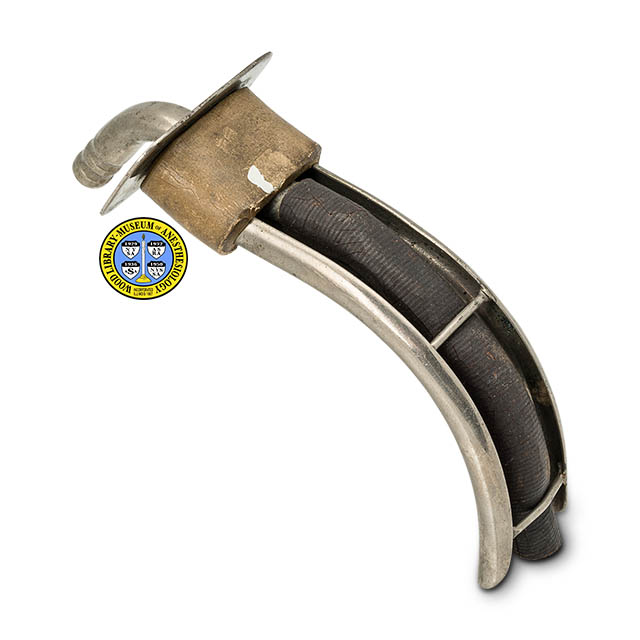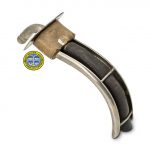Buettner Airway
Anesthesiologists are responsible for managing the patient's respiration during surgery. An artificial airway acts as a tongue depressor and as a breathing tube. John J. Buettner, M.D. (1874-1967), of Syracuse, New York, was among the first generation of American physicians to specialize in anesthesia. He invented an airway and a face mask, both made by New York's Foregger Company. The airway was offered in Foregger's catalogs from 1919 through 1959.
This unusual design has a fixed metal connector in the center, and allows open access to the interior. A short, rubber tube is attached to the connector on the inside, and a longer tube could be connected on the outside to deliver gas, as well as air or oxygen for resuscitation. Buettner's design included a rubber sleeve to protect the patient's teeth. The Buettner Airway was modified in 1925 by Thomas D. Buchanan, M.D. (1876-1940). Buchanan's airway appeared in Foregger's catalogs from 1922 through 1935. Two more airways made by Foregger have similar features, the Poe Airway and the Waters Airway.
Catalog Record: Buettner Airway Buettner Airway
Access Key: aqsl
Accession No.: 81
Title: [Buettner airway] / [designed by John J. Buettner].
Author: Buettner, John J. (John Joseph), born 1874.
Corporate Author: Foregger Company.
Publisher: New York : Foregger Company ; [between ca. 1919 and ca. 1959].
Physical Description: 1 airway : metals, rubber ; 3.5 x 4 x 11.5 cm.
Subject: Airways, Artificial.
Subject: Anesthesia, Inhalation – instrumentation.
Subject: Oropharyngeal Airway Devices.
Note Type: General
Notes: The first year in the range of possible dates of manufacture is the date of the first catalog in which the Buettner airway was found. The second year in the date range is the date of last catalog in which it was listed; the low accession number indicates that it is likely to have been made somewhat earlier.
Described from the patient’s point of view. The open side of the shaft is considered the top. The exterior end of the metal connector is considered the back.
Note Type: Citation
Notes: American Society of Anesthesiologists Archives, Membership Directories. Located at: Wood Library-Museum of Anesthesiology, Schaumburg, Illinois.
Note Type: Citation
Notes: Buettner JJ. Safety factors in the team work of operator and anesthetist. Transactions of the American Association of Obstetricians and Gynecologists for the Year 1919. York: Maple Press, 1920;32:45-51.
Note Type: Citation
Notes: Buettner JJ. Psychology in anesthesia. American Journal of Surgery, Anesthesia Supplement. January, 1924;38(1):9-11.
Note Type: Citation
Notes: Buettner JJ. Oxygen therapy. Anesth Analg. January-February, 1931;10(1):39-44.
Note Type: Citation
Notes: Dooley MS, Wells CJ, Frey JC, Knoff FH, Gabel WJ, Mordell JS, Buettner JJ, McElwain CE, Bentley CD. Clinical comparison of drum and special ethers. JAMA. September 28, 1935;105(13):1033-1034.
Note Type: Citation
Notes: Foregger Company. Catalog 1919. New York: The Foregger Company, 1919:44.
Note Type: Citation
Notes: Foregger Company. Catalog No. 15, 1959. New York: The Foregger Company, 1959:91.
Note Type: Citation
Notes: International Anesthesia Research Society Archives. Located at: Wood Library-Museum of Anesthesiology, Schaumburg, Illinois.
Note Type: Reproduction
Notes: Photographed by Mr. Steve Donisch, January 16, 2018.
Note Type: Historical
Notes: Anesthesiologists are responsible for managing the patient’s respiration during surgery. One of the tools they may use is an artificial airway. Placed in the patient’s mouth, it acts as a tongue depressor and a conduit for the administration of air and anesthetic gases. John J. Buettner, M.D. (b. 1874), of Syracuse, New York, was among the first generation of American physicians to specialize in anesthesia. He invented an airway and a face mask, both made by New York’s Foregger Company. Although he published several articles, it appears that he never described his inventions in print. His airway was offered in Foregger’s catalogs from 1919 through 1959.
This unusual design has a fixed metal connector in the center, and allows open access to the interior. A short, replaceable rubber tube was attached to the connector on the inside, and a longer tube could be connected on the outside to deliver gas, as well as air or oxygen for resuscitation. The metal tube is fixed to the bottom of the airway, and curves downward where it exits the airway. Buettner’s design included a rubber sleeve to protect the patient’s teeth. Foregger’s catalogs describe the Buettner Airway as being intended “only for pharyngeal insufflation in work above the mouth.”
The Buettner Airway was modified in 1925 by Thomas D. Buchanan, M.D. (1876-1940). Buchanan’s airway appeared in Foregger’s catalogs from 1922 through 1935. Two more airways made by Foregger have similar features. The Poe Airway, introduced in 1924, has two metal tubes inside rather one rubber tube; each of these tubes has a connector mounted on the side rather than the bottom of the airway. The all-metal Waters Airway lacked the cushioned bite block of Buettner’s airway.
Note Type: Exhibition
Notes: Selected for the WLM website.


